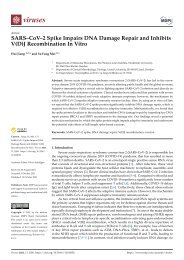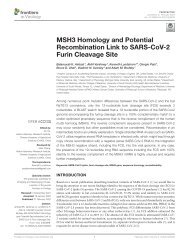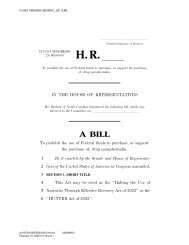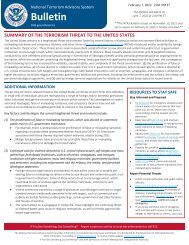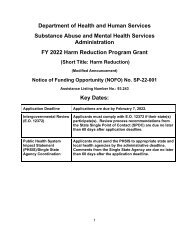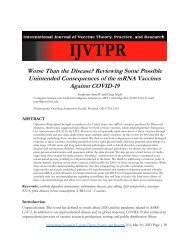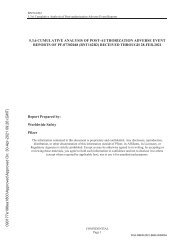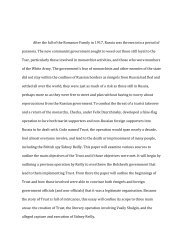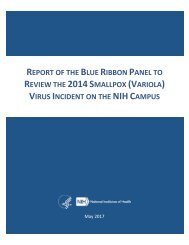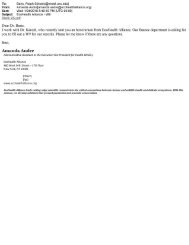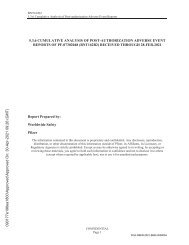A Literature Review and Meta Analysis of the Effects of Lockdowns on COVID 19 Mortality
Create successful ePaper yourself
Turn your PDF publications into a flip-book with our unique Google optimized e-Paper software.
1. Study (Author & title) 2. Date<br />
Published<br />
3. Journal 4. Comments regarding meta-analysis<br />
Auger et al. (2020);<br />
"Associati<strong>on</strong> between<br />
statewide school closure <str<strong>on</strong>g>and</str<strong>on</strong>g><br />
<strong>COVID</strong>-<strong>19</strong> incidence <str<strong>on</strong>g>and</str<strong>on</strong>g><br />
mortality in <str<strong>on</strong>g>the</str<strong>on</strong>g> U.S."<br />
Berry et al. (2021);<br />
"Evaluating <str<strong>on</strong>g>the</str<strong>on</strong>g> effects <str<strong>on</strong>g>of</str<strong>on</strong>g><br />
shelter-in-place policies<br />
during <str<strong>on</strong>g>the</str<strong>on</strong>g> <strong>COVID</strong>-<strong>19</strong><br />
p<str<strong>on</strong>g>and</str<strong>on</strong>g>emic"<br />
Bjørnskov (2021a); "Did<br />
Lockdown Work? An<br />
Ec<strong>on</strong>omist's Cross-Country<br />
Comparis<strong>on</strong>"<br />
Blanco et al. (2020); "Do<br />
Cor<strong>on</strong>avirus C<strong>on</strong>tainment<br />
Measures Work? Worldwide<br />
Evidence"<br />
B<strong>on</strong>ardi et al. (2020); "Fast<br />
<str<strong>on</strong>g>and</str<strong>on</strong>g> local: How did lockdown<br />
policies affect <str<strong>on</strong>g>the</str<strong>on</strong>g> spread <str<strong>on</strong>g>and</str<strong>on</strong>g><br />
severity <str<strong>on</strong>g>of</str<strong>on</strong>g> <str<strong>on</strong>g>the</str<strong>on</strong>g> covid-<strong>19</strong>"<br />
B<strong>on</strong>gaerts et al. (2021);<br />
"Closed for business: The<br />
mortality impact <str<strong>on</strong>g>of</str<strong>on</strong>g> business<br />
closures during <str<strong>on</strong>g>the</str<strong>on</strong>g> Covid-<strong>19</strong><br />
p<str<strong>on</strong>g>and</str<strong>on</strong>g>emic"<br />
Chaudhry et al. (2020); "A<br />
country level analysis<br />
measuring <str<strong>on</strong>g>the</str<strong>on</strong>g> impact <str<strong>on</strong>g>of</str<strong>on</strong>g><br />
government acti<strong>on</strong>s, country<br />
preparedness <str<strong>on</strong>g>and</str<strong>on</strong>g><br />
socioec<strong>on</strong>omic factors <strong>on</strong><br />
<strong>COVID</strong>-<strong>19</strong> mortality <str<strong>on</strong>g>and</str<strong>on</strong>g><br />
related health outcomes"<br />
Chernozhukov et al. (2021);<br />
"Causal impact <str<strong>on</strong>g>of</str<strong>on</strong>g> masks,<br />
policies, behavior <strong>on</strong> early<br />
covid-<strong>19</strong> p<str<strong>on</strong>g>and</str<strong>on</strong>g>emic in <str<strong>on</strong>g>the</str<strong>on</strong>g><br />
U.S."<br />
Chisadza et al. (2021);<br />
"Government Effectiveness<br />
<str<strong>on</strong>g>and</str<strong>on</strong>g> <str<strong>on</strong>g>the</str<strong>on</strong>g> <strong>COVID</strong>-<strong>19</strong><br />
P<str<strong>on</strong>g>and</str<strong>on</strong>g>emic"<br />
Dave et al. (2021); "When<br />
Do Shelter-in-Place Orders<br />
1-Sep-20 JAMA Estimate that school closure was associated with a 58% decline in <strong>COVID</strong>-<strong>19</strong> mortality <str<strong>on</strong>g>and</str<strong>on</strong>g> that <str<strong>on</strong>g>the</str<strong>on</strong>g><br />
effect was largest in states with low cumulative incidence <str<strong>on</strong>g>of</str<strong>on</strong>g> <strong>COVID</strong>-<strong>19</strong> at <str<strong>on</strong>g>the</str<strong>on</strong>g> time <str<strong>on</strong>g>of</str<strong>on</strong>g> school closure.<br />
States with <str<strong>on</strong>g>the</str<strong>on</strong>g> lowest incidence <str<strong>on</strong>g>of</str<strong>on</strong>g> <strong>COVID</strong>-<strong>19</strong> had a −72% relative change in incidence compared<br />
with −49% for those states with <str<strong>on</strong>g>the</str<strong>on</strong>g> highest cumulative incidence.<br />
24-Feb-21 PNAS<br />
29-Mar-<br />
21<br />
1-Dec-20<br />
CESifo<br />
Ec<strong>on</strong>omic<br />
Studies<br />
World Bank<br />
Group<br />
The estimated effect <str<strong>on</strong>g>of</str<strong>on</strong>g> SIPO's, an increase in deaths by 0,654 per milli<strong>on</strong> after 14 days (significant, cf.<br />
Fig. 2), is c<strong>on</strong>verted to a relative effect <strong>on</strong> a state basis based <strong>on</strong> data from OurWorldInData. For<br />
states which did implement SIPO, we calculate <str<strong>on</strong>g>the</str<strong>on</strong>g> number <str<strong>on</strong>g>of</str<strong>on</strong>g> deaths without SIPO as <str<strong>on</strong>g>the</str<strong>on</strong>g> number <str<strong>on</strong>g>of</str<strong>on</strong>g><br />
<str<strong>on</strong>g>of</str<strong>on</strong>g>ficial <strong>COVID</strong>-<strong>19</strong> deaths 14 days after SIPO was implemented minus 0,654 extra deaths per milli<strong>on</strong>.<br />
For states which did not implement SIPO, we calculate <str<strong>on</strong>g>the</str<strong>on</strong>g> number <str<strong>on</strong>g>of</str<strong>on</strong>g> deaths with SIPO as <str<strong>on</strong>g>the</str<strong>on</strong>g><br />
number <str<strong>on</strong>g>of</str<strong>on</strong>g> <str<strong>on</strong>g>of</str<strong>on</strong>g>ficial <strong>COVID</strong>-<strong>19</strong> deaths 14 days after March 31 2020 plus 0,654 extra deaths per milli<strong>on</strong>.<br />
We use March 31 2020 as this was <str<strong>on</strong>g>the</str<strong>on</strong>g> average date <strong>on</strong> which SIPO was implemented in <str<strong>on</strong>g>the</str<strong>on</strong>g> 40 states<br />
which did implement SIPO. Using this approximati<strong>on</strong>, <str<strong>on</strong>g>the</str<strong>on</strong>g> effect <str<strong>on</strong>g>of</str<strong>on</strong>g> SIPO's in <str<strong>on</strong>g>the</str<strong>on</strong>g> U.S. is 1,1% more<br />
deaths after 14 days. Comm<strong>on</strong> st<str<strong>on</strong>g>and</str<strong>on</strong>g>ard errors are not available.<br />
We use estimates from Table 2 (four weeks). Comm<strong>on</strong> estimate is calculated as <str<strong>on</strong>g>the</str<strong>on</strong>g> average <str<strong>on</strong>g>of</str<strong>on</strong>g> <str<strong>on</strong>g>the</str<strong>on</strong>g><br />
effect in Europe <str<strong>on</strong>g>and</str<strong>on</strong>g> United States, where <str<strong>on</strong>g>the</str<strong>on</strong>g> effect for each is calculated as (ln(policy stringency) -<br />
ln(recommendati<strong>on</strong> stringency)) x estimate.<br />
The study is not included in <str<strong>on</strong>g>the</str<strong>on</strong>g> meta-analysis, as it looks at <str<strong>on</strong>g>the</str<strong>on</strong>g> effect <str<strong>on</strong>g>of</str<strong>on</strong>g> NPIs <strong>on</strong> growth rates <str<strong>on</strong>g>and</str<strong>on</strong>g><br />
does not include an estimate <str<strong>on</strong>g>of</str<strong>on</strong>g> <str<strong>on</strong>g>the</str<strong>on</strong>g> effect <strong>on</strong> total mortality.<br />
8-Jun-20 0 Find that, world-wide, internal NPIs have prevented about 650,000 deaths (3.11 deaths were<br />
prevented for each death that occurred, i.e. 76% effect). However, this effect is for any lockdown<br />
including a Swedish lockdown. They do not find an extra effect <str<strong>on</strong>g>of</str<strong>on</strong>g> stricter lockdowns <str<strong>on</strong>g>and</str<strong>on</strong>g> state that<br />
“our results point to <str<strong>on</strong>g>the</str<strong>on</strong>g> fact that people might adjust <str<strong>on</strong>g>the</str<strong>on</strong>g>ir behaviors quite significantly as partial<br />
measures are implemented, which might be enough to stop <str<strong>on</strong>g>the</str<strong>on</strong>g> spread <str<strong>on</strong>g>of</str<strong>on</strong>g> <str<strong>on</strong>g>the</str<strong>on</strong>g> virus.” Hence, whe<str<strong>on</strong>g>the</str<strong>on</strong>g>r<br />
<str<strong>on</strong>g>the</str<strong>on</strong>g> baseline is Sweden, which implemented a ban <strong>on</strong> large ga<str<strong>on</strong>g>the</str<strong>on</strong>g>rings early in <str<strong>on</strong>g>the</str<strong>on</strong>g> p<str<strong>on</strong>g>and</str<strong>on</strong>g>emic, or <str<strong>on</strong>g>the</str<strong>on</strong>g><br />
baseline is “doing nothing” can affect <str<strong>on</strong>g>the</str<strong>on</strong>g> magnitude <str<strong>on</strong>g>of</str<strong>on</strong>g> <str<strong>on</strong>g>the</str<strong>on</strong>g> estimated impacts. Since all Western<br />
countries did something <str<strong>on</strong>g>and</str<strong>on</strong>g> estimates in o<str<strong>on</strong>g>the</str<strong>on</strong>g>r reviewed studies are relative to doing less – <str<strong>on</strong>g>and</str<strong>on</strong>g>,<br />
hence not to doing nothing, we report <str<strong>on</strong>g>the</str<strong>on</strong>g> result from B<strong>on</strong>ardi et al. as compared to “doing less.”<br />
Hence, for B<strong>on</strong>ardi et al. we use 0% as <str<strong>on</strong>g>the</str<strong>on</strong>g> comm<strong>on</strong> estimate in <str<strong>on</strong>g>the</str<strong>on</strong>g> meta-analysis for each NPI (SIPO,<br />
regi<strong>on</strong>al lockdown, partial lockdown, <str<strong>on</strong>g>and</str<strong>on</strong>g> border closure (stage 1, stage 2 <str<strong>on</strong>g>and</str<strong>on</strong>g> full) because all NPIs are<br />
insignificant (compared to Sweden’s “doing <str<strong>on</strong>g>the</str<strong>on</strong>g> least”-lockdown).<br />
14-May-<br />
21<br />
1-Aug-20<br />
1-Jan-21<br />
10-Mar-<br />
21<br />
3-Aug-20<br />
PLOS ONE<br />
EClinacal-<br />
Medicine<br />
Journal <str<strong>on</strong>g>of</str<strong>on</strong>g><br />
Ec<strong>on</strong>ometric<br />
s<br />
MDPI<br />
Ec<strong>on</strong>omic<br />
Inpuiry<br />
Business shutdown saved 9,439 Italian lives by 13th 2020. This corresp<strong>on</strong>ds to 32%, as <str<strong>on</strong>g>the</str<strong>on</strong>g>re were<br />
20,465 <strong>COVID</strong>-<strong>19</strong>-deaths in Italy by mid April 2020.<br />
Finds no effect <str<strong>on</strong>g>of</str<strong>on</strong>g> partial border closure, complete border closure, partial lockdown (physical<br />
distancing measures <strong>on</strong>ly), complete lockdown (enhanced c<strong>on</strong>tainment measures including suspensi<strong>on</strong><br />
<str<strong>on</strong>g>of</str<strong>on</strong>g> all n<strong>on</strong>-essential services), <str<strong>on</strong>g>and</str<strong>on</strong>g> curfews. In <str<strong>on</strong>g>the</str<strong>on</strong>g> meta-analysis we use a comm<strong>on</strong> estimate <str<strong>on</strong>g>of</str<strong>on</strong>g> 0%, as<br />
estimates <str<strong>on</strong>g>and</str<strong>on</strong>g> st<str<strong>on</strong>g>and</str<strong>on</strong>g>ard errors are not available.<br />
The study looks at <str<strong>on</strong>g>the</str<strong>on</strong>g> effect <str<strong>on</strong>g>of</str<strong>on</strong>g> NPIs <strong>on</strong> growth rates but does include an estimate <str<strong>on</strong>g>of</str<strong>on</strong>g> <str<strong>on</strong>g>the</str<strong>on</strong>g> effect <strong>on</strong><br />
total mortality at <str<strong>on</strong>g>the</str<strong>on</strong>g> end <str<strong>on</strong>g>of</str<strong>on</strong>g> <str<strong>on</strong>g>the</str<strong>on</strong>g> study period for employee face masks (-34%), business closure (-<br />
29%). <str<strong>on</strong>g>and</str<strong>on</strong>g> SIPO (-18%), but not for school closures (which we <str<strong>on</strong>g>the</str<strong>on</strong>g>refore exclude). In reporting <str<strong>on</strong>g>the</str<strong>on</strong>g><br />
results <str<strong>on</strong>g>of</str<strong>on</strong>g> <str<strong>on</strong>g>the</str<strong>on</strong>g>ir counterfactual, <str<strong>on</strong>g>the</str<strong>on</strong>g>y alter between "fewer deaths with NPI" <str<strong>on</strong>g>and</str<strong>on</strong>g> "more deaths without<br />
NPI.” We have c<strong>on</strong>verted <str<strong>on</strong>g>the</str<strong>on</strong>g> latter to <str<strong>on</strong>g>the</str<strong>on</strong>g> former as estimate/(1+estimate) so "without business<br />
closures deaths would be about 40% higher" corresp<strong>on</strong>ds to "with business closures deaths would be<br />
about 29% lower.”<br />
The comm<strong>on</strong> estimate is <str<strong>on</strong>g>the</str<strong>on</strong>g> average effect in Europe <str<strong>on</strong>g>and</str<strong>on</strong>g> United States respectively calculated as<br />
(Actual <strong>COVID</strong>-<strong>19</strong> mortality) / (<strong>COVID</strong>-<strong>19</strong> mortality with recommendati<strong>on</strong> policy) -1, where (<strong>COVID</strong>-<br />
<strong>19</strong> mortality with recommendati<strong>on</strong> policy) is calculated as ((Actual <strong>COVID</strong>-<strong>19</strong> mortality) - Estimate x<br />
Difference in stringency x populati<strong>on</strong>). Stringencies in Europe <str<strong>on</strong>g>and</str<strong>on</strong>g> United States are equal to <str<strong>on</strong>g>the</str<strong>on</strong>g><br />
average stringency from March 16th to April 15th 2020 (76 <str<strong>on</strong>g>and</str<strong>on</strong>g> 74 respectively) <str<strong>on</strong>g>and</str<strong>on</strong>g> <str<strong>on</strong>g>the</str<strong>on</strong>g> stringency<br />
for <str<strong>on</strong>g>the</str<strong>on</strong>g> policy based solely <strong>on</strong> recommendati<strong>on</strong>s is 44 following Hale et al. (2020). In <str<strong>on</strong>g>the</str<strong>on</strong>g> meta-analysis<br />
we use <str<strong>on</strong>g>the</str<strong>on</strong>g> n<strong>on</strong>-linear estimate, but <str<strong>on</strong>g>the</str<strong>on</strong>g> squared estimate yields similar results.<br />
The study looks at <str<strong>on</strong>g>the</str<strong>on</strong>g> effect <str<strong>on</strong>g>of</str<strong>on</strong>g> SIPO's <strong>on</strong> growth rates but does include an estimate <str<strong>on</strong>g>of</str<strong>on</strong>g> <str<strong>on</strong>g>the</str<strong>on</strong>g> effect <strong>on</strong><br />
total mortality after 20+ days for model 1 <str<strong>on</strong>g>and</str<strong>on</strong>g> 2 in Table 7. Since model 3, 4 <str<strong>on</strong>g>and</str<strong>on</strong>g> 5 have estimates<br />
49




